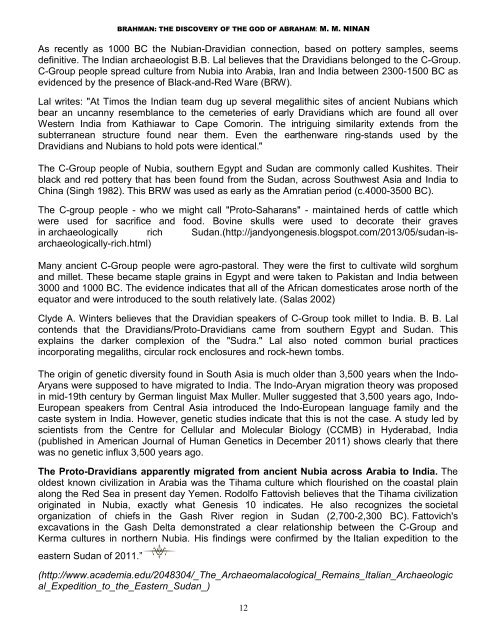Create successful ePaper yourself
Turn your PDF publications into a flip-book with our unique Google optimized e-Paper software.
BRAHMAN: THE DISCOVERY OF THE GOD OF ABRAHAM: M. M. NINAN<br />
As recently as 1000 BC the Nubian-Dravidian connection, based on pottery samples, seems<br />
definitive. The Indian archaeologist B.B. Lal believes that the Dravidians belonged to the C-Group.<br />
C-Group people spread culture from Nubia into Arabia, Iran and India between 2300-1500 BC as<br />
evidenced by the presence of Black-and-Red Ware (BRW).<br />
Lal writes: "At Timos the Indian team dug up several megalithic sites of ancient Nubians which<br />
bear an uncanny resemblance to the cemeteries of early Dravidians which are found all over<br />
Western India from Kathiawar to Cape Comorin. The intriguing similarity extends from the<br />
subterranean structure found near them. Even the earthenware ring-stands used by the<br />
Dravidians and Nubians to hold pots were identical."<br />
The C-Group people of Nubia, southern Egypt and Sudan are commonly called Kushites. Their<br />
black and red pottery that has been found from the Sudan, across Southwest Asia and India to<br />
China (Singh 1982). This BRW was used as early as the Amratian period (c.4000-3500 BC).<br />
The C-group people - who we might call "Proto-Saharans" - maintained herds of cattle which<br />
were used for sacrifice and food. Bovine skulls were used to decorate their graves<br />
in archaeologically rich Sudan.(http://jandyongenesis.blogspot.com/2013/05/sudan-isarchaeologically-rich.html)<br />
Many ancient C-Group people were agro-pastoral. They were the first to cultivate wild sorghum<br />
and millet. These became staple grains in Egypt and were taken to Pakistan and India between<br />
3000 and 1000 BC. The evidence indicates that all of the African domesticates arose north of the<br />
equator and were introduced to the south relatively late. (Salas 2002)<br />
Clyde A. Winters believes that the Dravidian speakers of C-Group took millet to India. B. B. Lal<br />
contends that the Dravidians/Proto-Dravidians came from southern Egypt and Sudan. This<br />
explains the darker complexion of the "Sudra." Lal also noted common burial practices<br />
incorporating megaliths, circular rock enclosures and rock-hewn tombs.<br />
The origin of genetic diversity found in South Asia is much older than 3,500 years when the Indo-<br />
Aryans were supposed to have migrated to India. The Indo-Aryan migration theory was proposed<br />
in mid-19th century by German linguist Max Muller. Muller suggested that 3,500 years ago, Indo-<br />
European speakers from Central Asia introduced the Indo-European language family and the<br />
caste system in India. However, genetic studies indicate that this is not the case. A study led by<br />
scientists from the Centre for Cellular and Molecular Biology (CCMB) in Hyderabad, India<br />
(published in American Journal of Human Genetics in December 2011) shows clearly that there<br />
was no genetic influx 3,500 years ago.<br />
The Proto-Dravidians apparently migrated from ancient Nubia across Arabia to India. The<br />
oldest known civilization in Arabia was the Tihama culture which flourished on the coastal plain<br />
along the Red Sea in present day Yemen. Rodolfo Fattovish believes that the Tihama civilization<br />
originated in Nubia, exactly what Genesis 10 indicates. He also recognizes the societal<br />
organization of chiefs in the Gash River region in Sudan (2,700-2,300 BC). Fattovich's<br />
excavations in the Gash Delta demonstrated a clear relationship between the C-Group and<br />
Kerma cultures in northern Nubia. His findings were confirmed by the Italian expedition to the<br />
eastern Sudan of 2011.”<br />
(http://www.academia.edu/2048304/_The_Archaeomalacological_Remains_Italian_Archaeologic<br />
al_Expedition_to_the_Eastern_Sudan_)<br />
12


















